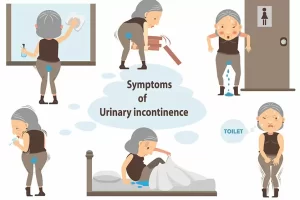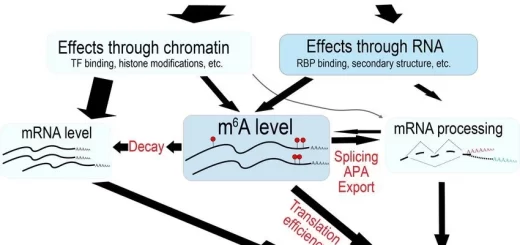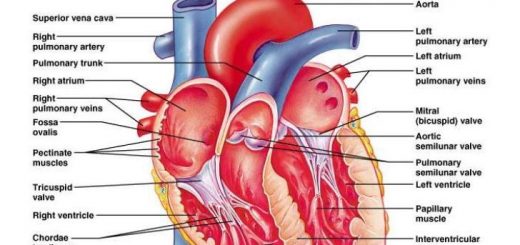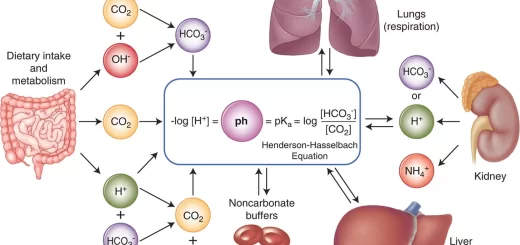Urinary incontinence in elderly causes and treatment, How to correct urinary incontinence?
Urinary incontinence in the elderly is one of the major problems facing the elderly. Continence requires adequate mobility, mentation, motivation, and manual skill. So problems outside the bladder often result in geriatric incontinence. Causes of urinary incontinence in the elderly are either “transient” or “established”.
Urinary incontinence in the elderly
International Continence Society defines urinary incontinence (UI) as the involuntary loss of urine. In both men and women, age is a consistently reported risk factor for UI; however, it is not considered a normal consequence of aging.
Overall, UI affects up to 30% of community-dwelling older adults and more than 50% of nursing home residents. It is about 2-3 times more common in women than in men until 80 years of age, after which UI rates are similar.
Despite its high prevalence, up to half of cases may not be reported because individuals with UI may not seek medical intervention. Embarrassment and the perception that UI is an expected consequence of aging are common factors in the lack of treatment.
Impact of UI
- It affects psychological well-being and quality of life.
- It may impair sexual function.
- It has been associated with an increased risk of UTIs, pressure ulcers, falls, fractures, and sleep disturbance.
- It restricts activities, interferes with interpersonal relationships, decreases self-esteem, and increases caregiver burden, and financial burden.
- It causes anxiety or depression.
- It is a common precipitant of institutionalization in older adults.
Age-related changes within the urinary tract contribute to the increased prevalence of urinary incontinence in the elderly.
- ↓ bladder compliance.
- ↓ bladder capacity.
- ↓ urethral closing pressure.
- ↓ Ability to postpone voiding.
- ↑ involuntary detrusor contractions.
- ↑ post-void residual.
- ↑ frequency of voiding.
- Weakened pelvic floor musculature (in women) and prostatic enlargement (in men).
Urinary incontinence classification
- Transient and established causes.
- According to pathophysiology and clinical presentation, it is classified into four main categories:
- Stress urinary incontinence.
- Urge urinary incontinence.
- Overflow incontinence,
- Functional incontinence.
Mixed types of incontinence are common and may complicate diagnosis and treatment because of overlapping symptoms.
1. Transient causes
- Delirium: Clouded sensorium impedes recognition of both the need to void and the location of the nearest toilet. Once delirium clears, incontinence usually resolves.
- Infection: Urinary tract infection causes or contributes to urgency and incontinence.
- Psychologic factors: severe depression with psychomotor retardation may impede the ability or motivation to reach a toilet.
- Excess urine output: may overwhelm the ability of an older person to reach the toilet in addition to diuretics, common causes include excess fluid intake, metabolic abnormalities e.g.; hyperglycemia, hypercalcemia, diabetes insipidus associated with peripheral edema like heart failure, venous insufficiency, malnutrition, cirrhosis and use of calcium channels blockers or N.SAIDs.
- Restricted mobility.
- Atrophic urethritis and vaginitis: Because it usually coexists with atrophic vaginitis. The presence of vaginal mucosal telangiectasia, petechiae, erosions erythema, or friability can diagnose the latter. Urethral inflammation may contribute to incontinence in women and can be improved by a trial of topical or oral estrogen.
- Stool impaction: Commonly causes urinary incontinence in hospitalized or immobile patients. The mechanism is still unknown. The clinical clue to its presence is urinary and fecal incontinence onset. Disimpaction restores both fecal and urinary incontinence.
- Drugs: Drugs are the most common causes of transient incontinence, Treatment of transient cause is treatment of the cause.
2. Established causes
1. Detrusor over activity (Urge incontinence):
- Leakage of urine (large volumes) because of the inability to delay voiding after the sensation of bladder fullness is perceived (caused by Detrusor overactivity and CNS disorders (e.g., stroke, parkinsonism, dementia).
- The term refers to uninhibited bladder contractions that cause leakage.
- It is the most common cause of established geriatric incontinence, accounting for two-thirds of cases is usually idiopathic.
- Women complain of urinary leakage after the onset of an intense urge to urinate which cannot be expected.
- In men symptoms are similar but detrusor overactivity commonly coexists with urethral obstruction due to benign prostatic hyperplasia.
- Detrusor overactivity may be due to bladder stones or tumors, so urge incontinence especially if accompanied by perineal or suprapubic discomfort or sterile hematuria should be investigated with cystoscopy and cytologic examination of a urine specimen.
2. Urethral incompetence (Stress incontinence)
- Is characterized by instantaneous leakage (small amount) of urine in response to a stress maneuver. (with ↑ intra-abdominal pressure coughing).
- Caused by weak pelvic floor muscles, bladder outlet or urethral sphincter weakness, post-urologic surgery.
- It is the second most common cause of established urinary incontinence in older women.
- It commonly coexists with Detrusor over activity.
- Urine loss occurs with laughing, coughing, or lifting heavy objects. The leakage is worse or occurs only during the day unless another abnormality coexists as Detrusor over activity.
Diagnosis: it is diagnosed by stand-up and cough test:
- Patients must relax their perineum and cough vigorously a single cough while standing with a full bladder.
- Instantaneous leakage indicates stress incontinence if retention with overflow has been excluded by sonography “post voiding residual determination”,
- A delay of several seconds or persistent leakages suggests that the problem is caused by urinary bladder contraction induced by coughing.
3. Urethral obstruction
- Is the second most common cause of established incontinence in older men (rare in women) due to prostatic enlargement, urethral stricture, bladder neck contracture or cancer prostate. It may present as dribbling incontinence after voiding, urge incontinence due to Detrusor over activity, which usually coexists with obstruction or overflow incontinence due to retention.
- Renal US is required to exclude hydronephrosis in men with post-voiding residual urine exceeding 150 ml For diagnosis urodynamic confirmation of obstruction is strongly advised.
4. Detrusor under activity: (Overflow incontinence)
- Is the least common cause of incontinence (<10%).
- Involuntary release of urine from an overfull urinary bladder, often in the absence of any urge to urinate.
- Etiology: Idiopathic or due to Anatomic obstruction by prostate, stricture, cystocele, A contractile bladder is associated with diabetes or spinal cord injury, Neurogenic is associated with multiple sclerosis or other spinal cord lesions and sacral lower motor nerve dysfunction, and Medications.
- Here incontinence is associated with urinary frequency, nocturia, and frequent leakage of small amounts (capacity of bladder = 450 ml + small amounts that are voided frequently.
- It is differentiated from detrusor-over activity by the presence of post-voiding residual volume over 450 ml. Also, it differentiates it from incontinence.
- In men, it needs urodynamic study to differentiate it from urethral obstruction.
You can follow science online on YouTube from this link: Science online
You can download Science Online application on Google Play from this link: Science online Apps on Google Play
Properties of cardiac muscles, Cardiac automaticity, and Conduction of electrical impulses
Histology of the heart, Cardiomyocyte types, Ultrastructure, and features of cardiac muscle fibers
Mediastinum contents, Aorta parts, Brachiocephalic trunk, Pulmonary trunk, and Thoracic duct trunk
Electrocardiogram (ECG) importance, ECG test results, analysis and abnormalities
Heart and Pericardium structure, Abnormalities, and Development of the heart
Heart function, structure, Valves, Borders, Chambers and Surfaces
Cardiac Markers review, definition, list, test, and myoglobin function




